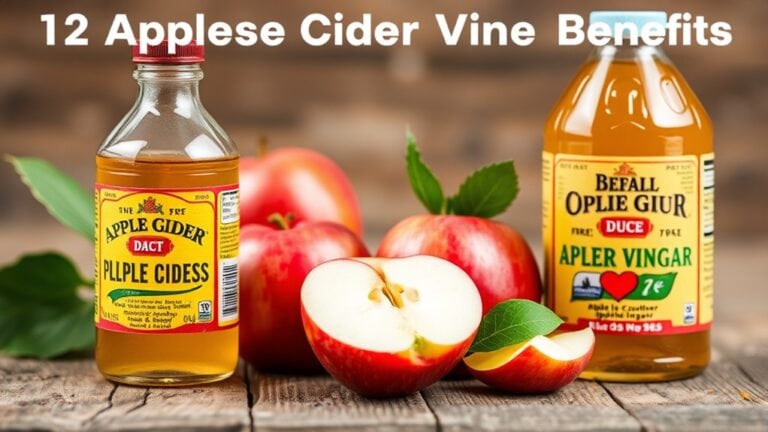You’re standing in the dairy aisle trying to decide between soy milk and almond milk, but the nutritional labels aren’t making it any easier. Should you have ever pondered which one packs more protein, keeps calories low, or fits better in your morning coffee, you’re not alone. Both have their perks, but their differences could surprise you—especially at the time it comes to taste, health benefits, and even their impact on the planet. So before you grab that carton, let’s analyze what sets them apart.
Protein Content: Soy Milk Vs Almond Milk
At the time it comes to protein, soy milk packs a much bigger punch than almond milk. Each 8-ounce glass of soy milk provides you 7-8 grams of protein per serving, close to cow’s milk, while almond milk only offers about 1 gram.
That’s a big difference should you be counting on your milk for muscle repair or staying full. Soy milk also delivers all the essential amino acids your body needs, making it a complete protein—something almond milk can’t match.
Nutritional profiles show soy milk brings extra B vitamins, boosting its health benefits.
Should you be after a dairy-free option that keeps protein high, soy milk wins. Almond milk may taste lighter, but for real fuel, soy’s the stronger pick.
Calorie Comparison: Which Milk Is Lower in Calories?
How do almond milk and soy milk stack up as you’re watching your calorie intake? Should you be looking for lower calories, almond milk is the winner, with just 30-39 calories per cup compared to soy milk’s 80-100 calories. Unsweetened varieties of both plant-based milk options cut calories further, but almond milk still comes out on top. Its lighter calorie content makes it a go-to for trimming caloric intake without sacrificing taste. Below’s a quick breakdown of their nutritional content:
| Milk Type | Calories (per cup) | Best For |
|---|---|---|
| Almond (unsweetened) | 30-39 | Low-calorie diets |
| Soy (unsweetened) | 80-100 | Higher protein |
Choose almond milk should calories be your main concern, but keep in mind soy milk packs more protein—just at a higher cost.
Fat Profile: Healthy Fats in Soy and Almond Milk
You’ll find both soy and almond milk contain mostly healthy unsaturated fats, but soy milk has a better balance of polyunsaturated and monounsaturated fats.
Unlike dairy milk, neither option has cholesterol, and they’re naturally low in saturated fat, which helps keep your heart happy.
Should you be watching your fat intake, almond milk has less overall fat, but soy milk offers more omega fatty acids.
Saturated Vs Unsaturated Fats
What exactly makes the fats in soy and almond milk better for your heart than those in dairy? It’s all about the balance of saturated fat and unsaturated fats.
Dairy milk packs more saturated fat, which can raise cholesterol levels, while soy milk and almond milk keep it low.
Soy milk offers a mix of monounsaturated and polyunsaturated fats, great for heart health. Almond milk leans heavier on monounsaturated fats, which also support a healthy heart.
Both have minimal saturated fat—way less than cow’s milk—so they’re smarter choices should you be watching your fat content. Plus, neither contains cholesterol, another win for your cardiovascular system.
Swapping dairy for these plant-based options means you’re choosing fats that work with your body, not against it.
Omega Fatty Acids Content
Saturated and unsaturated fats aren’t the only thing that sets plant-based milks apart—omega fatty acids play a big role too.
Soy milk shines with its mix of monounsaturated and polyunsaturated fats, including omega-3 and omega-6, which support heart health. Almond milk, while lower in fat overall, packs mostly monounsaturated fats, great for managing weight and cholesterol.
Both are low in saturated fat, making them smart choices for your heart. Should you be after a balance of healthy fats, soy milk edges ahead, but almond milk wins should you be watching calories.
Either way, unsweetened versions keep added sugars in check while maximizing their omega fatty acids content. Your heart will thank you for choosing either—just pick what fits your needs.
Cholesterol-Free Benefits
Since cholesterol only comes from animal products, plant-based milks like soy and almond offer a clear advantage: zero cholesterol, which means less strain on your heart.
Both are heart-healthy choices, packed with good fats that won’t clog your arteries. Soy milk has polyunsaturated and monounsaturated fats, great for your cardiovascular system, while almond milk’s lower fat content—just 2 to 4 grams per cup—makes it a lighter option.
Neither contains much saturated fat, so they’re kinder to your heart than dairy. Plus, many brands are fortified with calcium and vitamins, boosting their nutritional punch.
Whether you pick soy milk for its protein or almond milk for its subtle taste, you’re choosing a cholesterol-free drink that supports your health without compromise.
Micronutrient Breakdown: Vitamins and Minerals
Ever marvel how soy milk and almond milk stack up in regards to vitamins and minerals?
Soy milk contains more essential nutrients like iron and is often fortified with calcium and vitamins, including vitamin B12, which boosts energy. Almond milk contains less protein but shines with vitamin E, an antioxidant, and brands often add vitamin D for bone health.
Both can be fortified with calcium, but check labels—some have added sugars. Should you rely on these for daily nutrition, consult your health care provider to ascertain you’re meeting needs.
Soy milk’s potassium supports heart health, while almond milk’s lower calorie count might appeal to some. The choice depends on what nutrients matter most to you—strength, immunity, or simple variety.
Allergenic Potential: Soy Vs Almond Allergies
Upon selecting between soy milk and almond milk, it’s crucial to evaluate not just nutrition but also how your body responds. Allergic reactions to soy or almonds can range from mild discomfort to severe responses, so being aware of your triggers is key.
- Soy allergies are more common, affecting up to 0.4% of people, and are linked to proteins like Gly m 1.
- Almond allergies are rarer (around 0.1%) but can still cause serious reactions due to proteins like prunin.
- Cross-reactivity can occur—soy allergies could mean sensitivity to peanuts or lentils, complicating dietary choices.
- Hidden sources matter—soy milk contains soy proteins, while almond milk has almond proteins, so check labels carefully.
If you suspect allergies, consult a doctor before making either a staple in your diet.
Environmental Impact: Water Usage and Sustainability
Now that you’ve considered allergies, let’s talk about how your milk choice affects the planet. Almond milk has a heavy environmental impact due to its high water usage—it takes about 15 gallons of water to grow just 16 almonds. Soy milk, on the other hand, uses less water per unit of protein, making it a more sustainable option. Both crops rely on pesticides, which can harm ecosystems, but almonds often require more, adding to their footprint.
Here’s a quick comparison:
| Factor | Almond Milk | Soy Milk |
|---|---|---|
| Water Usage | High | Lower |
| Protein Yield | Less | More |
| Pesticide Use | Higher | Moderate |
| Ecosystem Impact | Greater risk | Less strain |
Choosing soy milk can ease pressure on water resources while still giving you protein.
Taste and Culinary Uses: Best Applications for Each Milk
You may observe soy milk’s creamy texture and bolder flavor work best in coffee or tea, while almond milk’s light nuttiness shines in smoothies or cereal.
At the time of baking, soy milk gives breads and pastries better structure, but almond milk’s subtle sweetness blends well in desserts like puddings.
In case you’re making sauces or dressings, almond milk’s mild flavor won’t overpower them, while soy milk holds its own in savory dishes.
Flavor Profiles Compared
– Almond milk has a naturally sweet, nutty taste, perfect for dessert recipes or light smoothies.
Its unsweetened versions keep sugar low without sacrificing flavor.
- Soy milk offers a creaminess closer to dairy, making it ideal for savory dishes like soups or sauces.
- The nutritional content differs too—soy milk’s higher protein gives it a richer mouthfeel, while almond milk stays light.
- In baking, soy milk’s texture mimics dairy better, but almond milk’s subtle sweetness works marvels in pancakes or muffins.
Choose based on whether you want sweetness or richness in your meals.
Best for Coffee Use
Should you be deciding between soy milk and almond milk for your coffee, texture and taste play a big role.
Soy milk’s higher protein content (7-8 grams per cup) gives it a creaminess that works well in lattes and cappuccinos, holding its texture better than almond milk and creating a rich foam.
Almond milk has a subtle nutty flavor that pairs nicely with flavored coffees, but its lower protein (1 gram per cup) means it couldn’t feel as creamy.
Should you love a dairy-like thickness, soy milk is your best bet.
Both won’t overpower your coffee’s flavor, though almond milk might leave a lighter mouthfeel.
Your choice depends on whether you prioritize creaminess or a lighter, nuttier sip.
Ideal Baking Applications
While picking between soy milk and almond milk for baking, it’s not just about swapping dairy—it’s about matching flavors and textures to your recipe. Each milk shines in different baking applications, so choosing wisely guarantees your dish turns out just right.
- Almond milk adds a subtle nutty flavor, perfect for cakes and cookies, but its lower protein content means you could need extra liquid to match dairy milk’s texture.
- Soy milk works best in savory dishes like quiches or creamy desserts, thanks to its neutral taste and higher protein content, which mimics dairy’s richness.
- For cream-based recipes, soy milk’s creaminess wins, while almond milk’s lightness suits delicate baked goods.
- While substituting for dairy milk, soy milk often swaps 1:1, but almond milk might need adjustments for moisture.
Pick based on flavor and texture—your recipe will thank you!
Conclusion
So there you have it—your milk dilemma solved! Whether you’re team soy (protein-packed powerhouse) or team almond (lightweight sipper), just recollect: one’s basically a gym buddy in liquid form, the other’s like flavored water pretending to be milk. Either way, you win—unless you’re allergic, then… oops. Pick your potion and pour boldly, because life’s too short to milk the wrong choice. (But perhaps skip the almond milk bodybuilding plan.)




